AMD Beema/Mullins Architecture & Performance Preview
by Anand Lal Shimpi on April 29, 2014 12:00 AM ESTThe Discovery Tablet
AMD is in a difficult position these days. Traditionally it was the cheaper alternative to Intel, but with Bay Trail Intel made a serious push into segments where OEMs would traditionally use lower cost AMD silicon. In an attempt to be more than a lower cost Intel alternative, AMD is throwing its hat into the form factor reference design race and offering OEMs an example of a full, ideal, high performance implementation of its silicon. One such example is AMD’s Discovery Tablet, an 11.6-inch 1080p Windows 8.1 tablet design that features AMD’s highest end A10 Micro-6700T Mullins silicon. The tablet is a bit larger and heavier than I’d like. If AMD is going to build a reference platform I’d prefer it to be a form factor I’d actually use, which in a tablet is going to be something smaller than 11.6-inches. If you are trying to cover both tablet and 2-in-1 form factors however, the Discovery Tablet makes sense.
I was allowed to spend a few hours benchmarking AMD’s Discovery Tablet. Unfortunately the device wasn’t instrumented for power testing, nor was there enough time to run any battery life tests on it, so the usefulness of these numbers is limited. We already know that AMD’s idle power isn’t as good as smartphone silicon, but for some of these value Windows 8.1 devices it may still be good enough.
Tablet JS/Web Browser Tests
We'll start with our usual set of JavaScript tests. Here we see AMD's A10 Micro-6700T outperform everything on the list. Whether we're talking about Bay Trail or Apple's A7, the 6700T pulls ahead by a decent margin. Once again the big question is how much power is being drawn to deliver this performance. Unlike Intel's Bay Trail preview, AMD didn't have any instrumented Discovery tablets setup for us to monitor power consumption. I suspect AMD's power consumption is competitive, but my guess is it isn't similarly class leading.
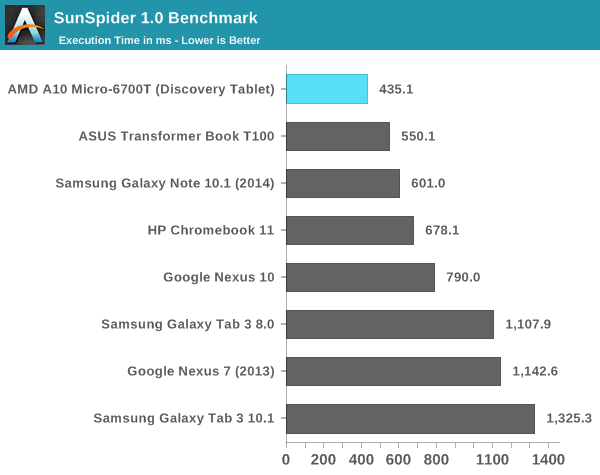
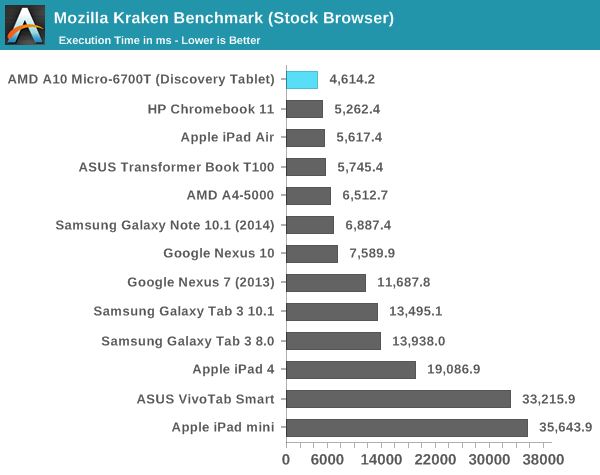

CPU Performance
For these next tests I turned to some of our more traditional Windows PC benchmarks. I looked at Cinebench 11.5 to get an idea for how single and multithreaded performance have changed since last year.
Looking at single threaded performance we immediately see the benefits of AMD's new boosting capabilities. The Puma+ cores are 35% faster than Intel's Silvermont cores, and can deliver nearly 80% of the performance of AMD's Piledriver cores found in Trinity. I threw some Llano results in here as well - Mullins offers around 85% of the performance of Llano.
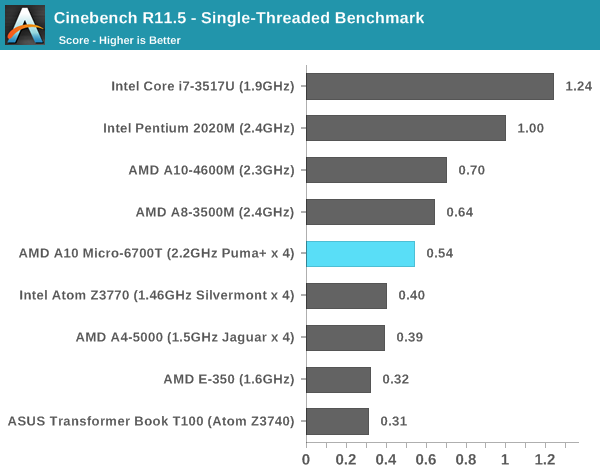
Multithreaded performance is pretty evenly matched between Bay Trail and Mullins here. Note that Mullins manages to deliver very similar performance to Kabini, despite coming in at substantially less power. The comparison to Brazos (E-350) is laughable, Mullins is substantially faster.
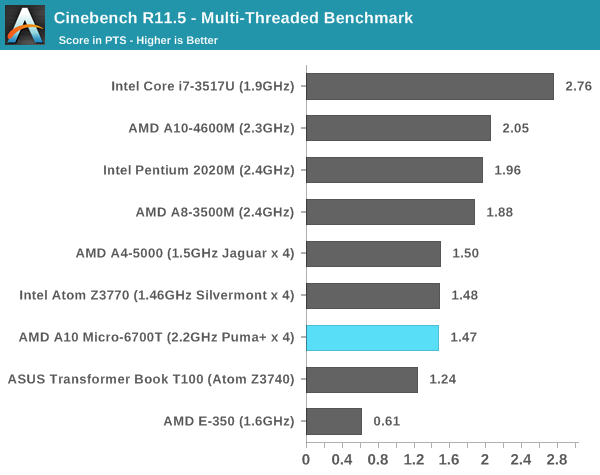
PCMark 7 gives us a better look at the overall performance of the Discovery tablet hardware. Here we do see it lose ground to the Kabini notebook (A4-5000) as well as the Bay Trail devices. It's unclear to me if we are seeing the thermal limits of the hardware (this is a longer test) or if there are other elements at work here (e.g. storage performance limits).
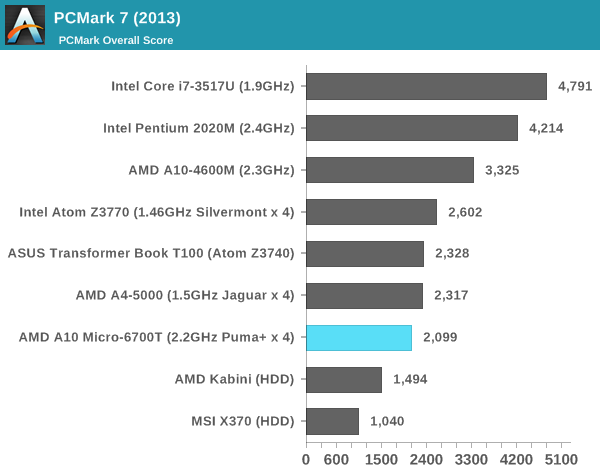
GPU Performance
We don’t actually have any Bay Trail devices in our Laptop 2013 bench, they are all in our Tablet 2013 category, which unfortunately uses different benchmarks. To make a long story short, we have Bay Trail vs. Kabini data, and Kabini vs. Mullins data. Thankfully the comparison between Bay Trail and Mullins is pretty easy to make.
AMD’s 4.5W TDP A10 Micro-6700T delivers roughly the same GPU performance as a 15W A4-5000. The A4-5000 also ends up being anywhere from 50% to over 2x the speed of Bay Trail when it comes to GPU performance, so you can expect Mullins to hold roughly the same advantage.
Compared to the old 35W Trinity, Mullins still has a ways to go. Trinity delivers roughly 2x the performance of Mullins, although at nearly 10x the TDP.
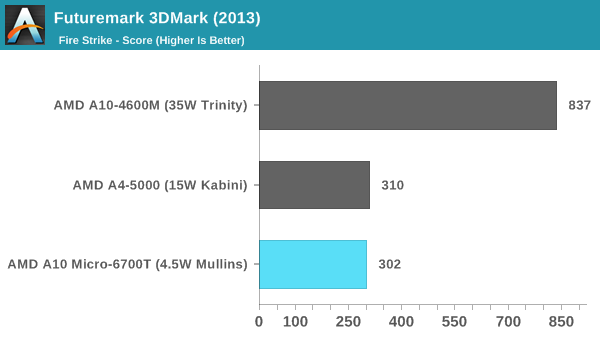
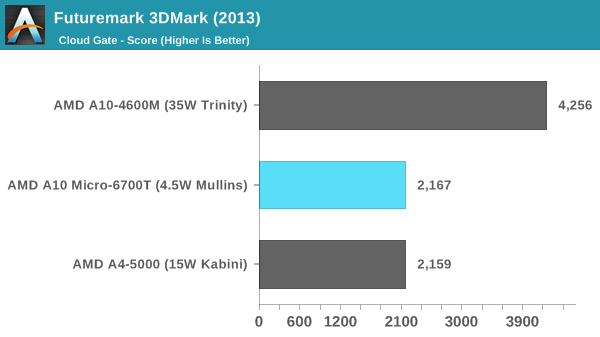
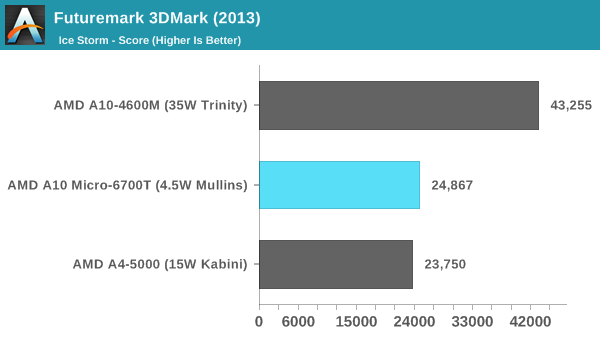


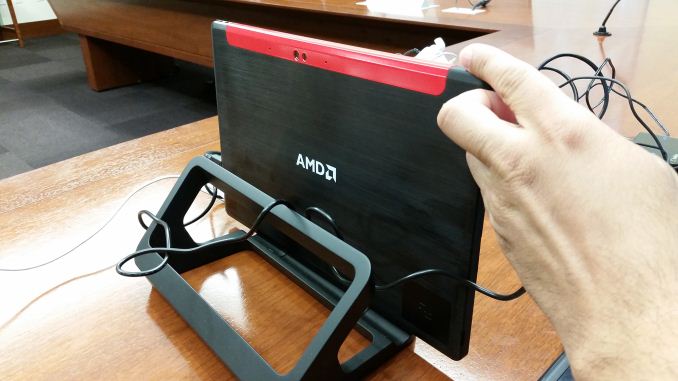
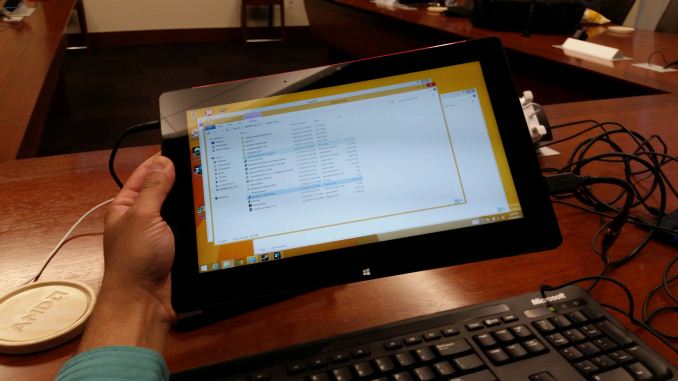














82 Comments
View All Comments
vlad42 - Tuesday, April 29, 2014 - link
Hey Anand,Do you know if connected standby was enabled on the Mullins tablet you tested? I’ve heard that AMD has not yet developed the connected standby drivers yet. If this is the case, then shouldn’t that be noted in the power consumption test? Given the improvements Intel sees when connected standby is enabled, it definitely looks like the Mullins tablet was not using connected standby.
Anand Lal Shimpi - Tuesday, April 29, 2014 - link
No CS, although I believe Mullins could theoretically support it. For this particular test there should be no advantage to having CS, we're just looking at short/active idle power usage.Anand Lal Shimpi - Tuesday, April 29, 2014 - link
Correction - there are no plans to support CS, AMD doesn't see value in it.tomsworkshop - Tuesday, April 29, 2014 - link
this low power but high performance tiny little chip can be fit on something like the raspberry pi, we can build a really small micro pc with such hardware.mfoley93 - Wednesday, April 30, 2014 - link
They aren't low power enough yet, so in the mean time, I suspect nVIDIA's Jetson board based off the Tegra K1 might fit the spot you are thinking of. The board is significantly larger, but its powerful enought to justify that. It's also more in the Beagleboard/Pandaboard segment, being aimed at embedded development and not education.http://www.nvidia.com/object/jetson-tk1-embedded-d...
tomsworkshop - Thursday, May 1, 2014 - link
The Tegra K1 rated at 5W TDP, the Mullins rated at 3.95W - 4.5W TDP, i think they should be low power enough for a single board computer, i saw the price for the Jetson TK1, it was 3 times higher than the Raspberry Pi, hope that AMD will come out something at the middle of the Raspberry Pi and Jetson TK1, with the price lower than the Jetson TK1, and the performance better than the Raspberry Pi.nemi2 - Tuesday, April 29, 2014 - link
It's good to see AMD catching up but the power consumption may still be a deciding factor when choosing between this and Baytrail - I look forward to a full review of release hardware. The other area of concern is that the Baytrail successor Airmont (with shrink to 14nm and ~30% power savings) will also be out in 2014 so AMD may only have 0-3 months at parity/competitiveness with intel.H2323 - Tuesday, April 29, 2014 - link
Yes these are shorty terms wins, but 14nm airmont is late and will miss back to school and be just in time for christmas, AMD will net some revenue on this and still retain GPU lead with baytrailR3MF - Tuesday, April 29, 2014 - link
a four-core mullins in an 8" tablet chassis with 4GB of memory and bios support for a 64bit ubuntu would be an awesome thing.MrSpadge - Tuesday, April 29, 2014 - link
I'd rather have a Thinkpad 10 + Win 8.1 with this, at least as an option instead of Bay Trail. If the actual product is as impressive as the preview.